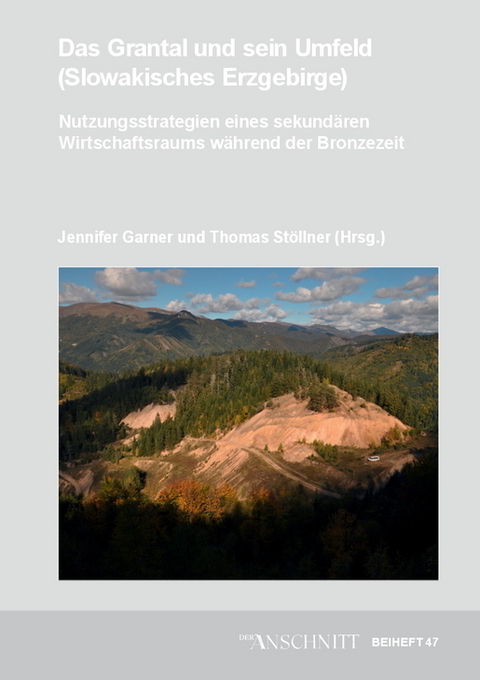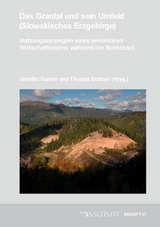Veröffentlichungen aus dem Deutschen Bergbau-Museum Bochum / Das Grantal und sein Umfeld (Slowakisches Erzgebirge)
Nutzungsstrategien eines sekundären Wirtschaftsraumes während der Bronzezeit
Seiten
2022
VML Vlg Marie Leidorf (Verlag)
978-3-86757-041-1 (ISBN)
VML Vlg Marie Leidorf (Verlag)
978-3-86757-041-1 (ISBN)
Das Slowakische Erzgebirge in der Mittelslowakei, welches zu den Westkarpaten gehört, zählt zu einer der wichtigsten metallogenetischen Zonen Mitteleuropas. Die Frage nach einer prähistorischen Nutzung war aufgrund der reichhaltigen Metallfunde und Metallurgienachweise in den letzten Jahrzehnten öfter Gegenstand unterschiedlicher Untersuchungen, konnte aber wegen der komplexen, mehrphasigen Lagerstättengenese, auch im Vergleich mit den Lagerstätten Serbiens / Bulgariens sowie der Alpen, nur eingeschränkt beantwortet werden. Grundsätzlich zeigten die Untersuchungen jedoch die Bedeutung der slowakischen Lagerstätten als Rohstofflieferant, neben den Ostalpen, seit dem 4. Jt. v.Chr. Dennoch mussten Fragen nach der Nutzung der Montanregion selbst sowie nach der Organisation der Ausbeutung der Lagerstätten sowie deren positive Identifizierung als Rohstofflieferant bisher offenbleiben. Auch die Handelswege zwischen der Montanregion und ihrem Umfeld sowie die Einbindung der bekannten Großsiedlungen in den Flusstälern und überhaupt die Struktur der kupfer- und bronzezeitlichen Siedlungsmuster sind größtenteils ungeklärt. Montanarchäologische Forschungen blieben eher im Hintergrund und Vorarbeiten erfolgten nur in Špania Dolina in den 1970er Jahren, wo die auf den spätmittelalterlich-neuzeitlichen Halden verteilten Schlägel- und Keramikfunde eine kupferzeitliche bis bronzezeitliche Nutzung nahelegen. Im Rahmen eines Verbundprojektes, die wirtschaftlichen Grundlagen der frühbronzezeitlichen Besiedlung im Grantal und Žitavatal zu untersuchen, wurde das Deutsche Bergbau-Museum Bochum eingeladen, sich an der montanarchäologischen Erforschung des westlichen slowakischen Erzgebirges zu beteiligen. Es folgten metallurgische und archäologische Untersuchungen zur Metallverarbeitung der Siedlung Fidvar bei Vràble sowie auf ihre umgebende Mikroregion. Einen weiteren Schwerpunkt bildeten montanarchäologische Prospektionen sowie Ausgrabungen der potentiell bronzezeitlich genutzten Erzlagerstätten bei Banská Bystrica in L’ubietová und Poniky. Schließlich stand die Kupferlagerstätte von Špania Dolina [Herrengrund], welche aufgrund von Steinschlägelfunden und Keramikfunden in Piesky [Sandberg] bereits seit der Kupferzeit ausgebeutet worden ist im Fokus der Geländearbeiten. Die Ergebnisse dieser Untersuchungen werden in diesem Band vorgestellt.
The Slovakian Ore Mountains in central Slovakia, which are part of the Western Carpathians, are one of the most important metallogenic regions in central Europe. Over the last decades, the question of their prehistoric use was addressed in several studies, given the rich metal finds and indications of metallurgy, but could only partly be answered due to the complex, multi-phase genesis of the ore deposits, also in comparison to the deposits in Serbia / Bulgaria and the Alps. However, at a general level these studies succeeded in showing the importance of the Slovak deposits as raw material sources from the 4th millennium B.C. onwards, alongside the eastern Alps. Nevertheless, questions concerning the use of the area itself, the organisation of deposit exploitation and the their positive identification as raw material sources have hitherto had to remain open. In addition, the trade routes between the mining area and its surroundings, as well as the integration of the known large-scale settlements in the river valleys and in general the structure of Copper and Bronze Age settlement patterns remain largely unaddressed. Research into mining archaeology has remained somewhat in the background, and initial work was only carried out in Špania Dolina in the 1970s, where finds of mallets and pottery on late medieval and early modern waste dumps suggested use in the Copper and Bronze Ages. Within the framework of a collaborative project focusing on the economic basis of the Early Bronze Age settlement of the Žitava valley, the Deutsches Bergbau-Museum Bochum was invited to contribute to the mining archaeological investigation of the western Slovak Ore Mountains. This was followed by metallurgical and archaeological research on metalworking in the settlement of Fidvar near Vràble and the surrounding micro-region. A further focus was formed by mining archaeological prospection and the excavation of the ore deposits near Banská Bystrica in L’ubietová and Poniky, which were possibly used in the Bronze Age. Finally, the copper deposit of Špania Dolina [Herrengrund] was the centre of targeted fieldwork, as stone mallet and pottery finds from Piesky [Sandberg] indicated its exploitation since the Copper Age. This volume presents the results of our investigations. The Slovakian Ore Mountains in central Slovakia, which are part of the Western Carpathians, are one of the most important metallogenic regions in central Europe. Over the last decades, the question of their prehistoric use was addressed in several studies, given the rich metal finds and indications of metallurgy, but could only partly be answered due to the complex, multi-phase genesis of the ore deposits, also in comparison to the deposits in Serbia / Bulgaria and the Alps. However, at a general level these studies succeeded in showing the importance of the Slovak deposits as raw material sources from the 4th millennium B.C. onwards, alongside the eastern Alps. Nevertheless, questions concerning the use of the area itself, the organisation of deposit exploitation and the their positive identification as raw material sources have hitherto had to remain open. In addition, the trade routes between the mining area and its surroundings, as well as the integration of the known large-scale settlements in the river valleys and in general the structure of Copper and Bronze Age settlement patterns remain largely unaddressed. Research into mining archaeology has remained somewhat in the background, and initial work was only carried out in Špania Dolina in the 1970s, where finds of mallets and pottery on late medieval and early modern waste dumps suggested use in the Copper and Bronze Ages. Within the framework of a collaborative project focusing on the economic basis of the Early Bronze Age settlement of the Žitava valley, the Deutsches Bergbau-Museum Bochum was invited to contribute to the mining archaeological investigation of the western Slovak Ore Mountains. This was followed by metallurgical and archaeological research on metalworking in the settlement of Fidvar near Vràble and the surrounding micro-region. A further focus was formed by mining archaeological prospection and the excavation of the ore deposits near Banská Bystrica in L’ubietová and Poniky, which were possibly used in the Bronze Age. Finally, the copper deposit of Špania Dolina [Herrengrund] was the centre of targeted fieldwork, as stone mallet and pottery finds from Piesky [Sandberg] indicated its exploitation since the Copper Age. This volume presents the results of our investigations.
The Slovakian Ore Mountains in central Slovakia, which are part of the Western Carpathians, are one of the most important metallogenic regions in central Europe. Over the last decades, the question of their prehistoric use was addressed in several studies, given the rich metal finds and indications of metallurgy, but could only partly be answered due to the complex, multi-phase genesis of the ore deposits, also in comparison to the deposits in Serbia / Bulgaria and the Alps. However, at a general level these studies succeeded in showing the importance of the Slovak deposits as raw material sources from the 4th millennium B.C. onwards, alongside the eastern Alps. Nevertheless, questions concerning the use of the area itself, the organisation of deposit exploitation and the their positive identification as raw material sources have hitherto had to remain open. In addition, the trade routes between the mining area and its surroundings, as well as the integration of the known large-scale settlements in the river valleys and in general the structure of Copper and Bronze Age settlement patterns remain largely unaddressed. Research into mining archaeology has remained somewhat in the background, and initial work was only carried out in Špania Dolina in the 1970s, where finds of mallets and pottery on late medieval and early modern waste dumps suggested use in the Copper and Bronze Ages. Within the framework of a collaborative project focusing on the economic basis of the Early Bronze Age settlement of the Žitava valley, the Deutsches Bergbau-Museum Bochum was invited to contribute to the mining archaeological investigation of the western Slovak Ore Mountains. This was followed by metallurgical and archaeological research on metalworking in the settlement of Fidvar near Vràble and the surrounding micro-region. A further focus was formed by mining archaeological prospection and the excavation of the ore deposits near Banská Bystrica in L’ubietová and Poniky, which were possibly used in the Bronze Age. Finally, the copper deposit of Špania Dolina [Herrengrund] was the centre of targeted fieldwork, as stone mallet and pottery finds from Piesky [Sandberg] indicated its exploitation since the Copper Age. This volume presents the results of our investigations. The Slovakian Ore Mountains in central Slovakia, which are part of the Western Carpathians, are one of the most important metallogenic regions in central Europe. Over the last decades, the question of their prehistoric use was addressed in several studies, given the rich metal finds and indications of metallurgy, but could only partly be answered due to the complex, multi-phase genesis of the ore deposits, also in comparison to the deposits in Serbia / Bulgaria and the Alps. However, at a general level these studies succeeded in showing the importance of the Slovak deposits as raw material sources from the 4th millennium B.C. onwards, alongside the eastern Alps. Nevertheless, questions concerning the use of the area itself, the organisation of deposit exploitation and the their positive identification as raw material sources have hitherto had to remain open. In addition, the trade routes between the mining area and its surroundings, as well as the integration of the known large-scale settlements in the river valleys and in general the structure of Copper and Bronze Age settlement patterns remain largely unaddressed. Research into mining archaeology has remained somewhat in the background, and initial work was only carried out in Špania Dolina in the 1970s, where finds of mallets and pottery on late medieval and early modern waste dumps suggested use in the Copper and Bronze Ages. Within the framework of a collaborative project focusing on the economic basis of the Early Bronze Age settlement of the Žitava valley, the Deutsches Bergbau-Museum Bochum was invited to contribute to the mining archaeological investigation of the western Slovak Ore Mountains. This was followed by metallurgical and archaeological research on metalworking in the settlement of Fidvar near Vràble and the surrounding micro-region. A further focus was formed by mining archaeological prospection and the excavation of the ore deposits near Banská Bystrica in L’ubietová and Poniky, which were possibly used in the Bronze Age. Finally, the copper deposit of Špania Dolina [Herrengrund] was the centre of targeted fieldwork, as stone mallet and pottery finds from Piesky [Sandberg] indicated its exploitation since the Copper Age. This volume presents the results of our investigations.
| Erscheinungsdatum | 31.05.2022 |
|---|---|
| Reihe/Serie | Der ANSCHNITT ; 47 | Veröffentlichungen aus dem Deutschen Bergbau-Museum Bochum ; 248 |
| Verlagsort | Rahden |
| Sprache | deutsch |
| Maße | 210 x 298 mm |
| Gewicht | 1290 g |
| Einbandart | gebunden |
| Themenwelt | Geschichte ► Allgemeine Geschichte ► Vor- und Frühgeschichte |
| Schlagworte | Bronzezeit • Kupfer • Kupfergewinnung • Montanarchäologie • Slowakei |
| ISBN-10 | 3-86757-041-8 / 3867570418 |
| ISBN-13 | 978-3-86757-041-1 / 9783867570411 |
| Zustand | Neuware |
| Haben Sie eine Frage zum Produkt? |
Mehr entdecken
aus dem Bereich
aus dem Bereich
auf den Spuren der frühen Zivilisationen
Buch | Hardcover (2023)
C.H.Beck (Verlag)
20,00 €
Was Pompeji über uns erzählt
Buch | Hardcover (2023)
Propyläen (Verlag)
32,00 €




